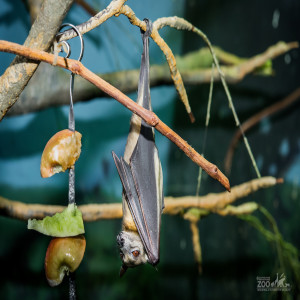African Straw-Colored Fruit Bat
[Eidolon helvum]

"The straw-colored fruit bat is a large bat, megachiroptera, about 5 to 8 inches (130 to 210 mm) in length. The neck and back are yellow-brown (hence, the name of straw-color), but the underside fur is a darker brown color. The wings are long and narrow, with a span of as much as 30 inches, allowing the bats to fly long distances. The bat has a long snout like a dog, and large eyes. The straw-colored fruit bat weighs 8 - 12 ounces. These bats can pollinate flowers and dispense seeds through the forests.
Location: The Lower RainForest
Share:
Range
Straw colored fruit bats are common in central Africa, but they can migrate to all of Africa, the Arabian peninsula south of the Sahara Desert and Madagascar.
Habitat
Straw colored fruit bats inhabit forest and savanna regions, in trees, caves and protected areas to elevations of 7000 feet.
Conservation Status
Near ThreatenedPrimary Threats
Human Wildlife Coexistence. Habitat loss, used as bushmeat in West and Central Africa.Gestation
Gestation in straw colored fruit bats is 9 months total, but embryonic development is only 4 to 5 months. Upon birth the bat weighs 45 to 50 grams.
Litter
Litters are usually only one pup.
Behavior
Straw-colored fruit bats occupy a wide range of habitats. They are a very social animal, and roost in colonies, typically in trees, numbering over 100,000 individuals. Typically the fruit bat does not find food by sound, echolocate. The bat is nocturnal, and it seeks food at night, using its excellent senses of sight and smell. These fruit bats have a peculiar habit of chewing on soft wood, probably to obtain water and moisture. The median life span is 5 years.
Reproduction
The straw-colored fruit bat reaches sexual maturity at about 18 months of age. Mating occurs from April to June, but implantation of the embryo for development in the uterus is delayed to ensure birth of the single pup during September to October. The pup is born in February to March. This takes advantage of the rainy season, for the mating and birth processes, when food is more abundant. The female gives parental care, nursing her pup until it is ready to forage on its own.
Wild Diet
Flowers, fruits and fruit juices

